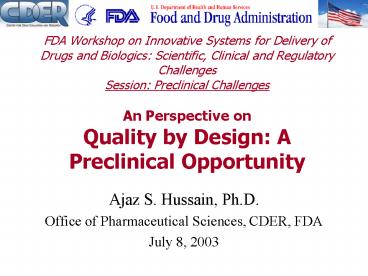Ajaz S. Hussain, Ph.D. - PowerPoint PPT Presentation
1 / 18
Title:
Ajaz S. Hussain, Ph.D.
Description:
IN VITRO PHYSICAL-CHEMICAL PROPERTIES. IN VIVO PHYSICAL-CHEMICAL PROPERTIES ... PHARMACOKINETIC PROPERTIES. Typical CMC and cGMP Considerations ... – PowerPoint PPT presentation
Number of Views:80
Avg rating:3.0/5.0
Title: Ajaz S. Hussain, Ph.D.
1
FDA Workshop on Innovative Systems for Delivery
of Drugs and Biologics Scientific, Clinical and
Regulatory ChallengesSession Preclinical
ChallengesAn Perspective on Quality by Design
A Preclinical Opportunity
- Ajaz S. Hussain, Ph.D.
- Office of Pharmaceutical Sciences, CDER, FDA
- July 8, 2003
2
Current Initiatives at FDA
- Promoting, Protecting the Public Health
- The PAT Initiative
- http//www.fda.gov/cder/OPS/PAT.htm
- cGMPs for the 21st Century Initiative
- http//www.fda.gov/cder/gmp/index.htm
- This workshop Improving Innovation in Medical
Technology Beyond 2002 - http//www.fda.gov/bbs/topics/news/2003/beyond2002
/report.html
3
Evolutionary Steps Pharmaceutical Product
Process Development
- Art Science Engineering based
- Dosage forms Drug Delivery Sys. Intelligent
Drug Delivery - Trial-and-Error DOE CAD
- Few creative options tested Many creative
options tested - End product testing Real time QA
- Batch processing Continuous processing
The first version of this slide was created in
1991 for a graduate course Advanced Drug
Delivery Systems at the University of
Cincinnati. Ajaz Hussain
4
Dosage Forms Performance
5
Typical CMC and cGMP Considerations
- Ensuring consistent quality and performance
- Design (specifications)
- Manufacturing process and controls
- Test methods and Shelf-life
- Process validation and manufacturing under cGMP
- Bridging Studies
- Post-Approval Changes
- Continuous Improvement
6
Drug Delivery System
Anatomy, Physiology, Pathology,..
Pharmacology, Pharmacokinetics
Delivery System
Biopharmaceutics
Physico-Chemical Attributes
7
Quality by Design
- Achievement of product and process performance
characteristics that are adequate for their
intended use through scientific understanding and
management of sources of variation and other risk
factors during manufacture.
8
Design Objectives
9
Drug Delivery Systems
- Past/Present
- Route of admn.
- Deployment relatively simple
- Drug delivery rate based on PK(/PD)
- Improve compliance
- Improve SE
- Present/Future
- Deployment simple to complex (surgical)
- Delivery to target site(s)
- Quality and performance consistency based on
traditional chemistry testing - Gaps in physical test methods
- Need to be proactive for future products
10
Defining Design Considerations and
Specifications Intended use?
- Intracoronary stents are deployed to form a
scaffolding for the coronary artery vessel wall
during coronary angioplasty, thereby preventing
recoil of the atherosclerotic vessel wall or
protrusion of plaques or dissected intimal flaps
into vascular lumen - greater luminal dilatation than balloon
angioplasty alone (e.g., N Engl J Med 331 (1994),
pp. 489495 Am J Cardiol 81 (1998), pp.
12861291)
11
The leading processes of restenosis (solid lines)
and correspondent inhibitory (dashed lines)
effects of different biological agents. MMP
indicates matrix metalloproteinase VEGF,
vascular endothelial growth factor.
Circulation. 20031072383-2389
12
How should we identify and optimize critical
factors?
- Trial-n-error experimentation under all or
selected (critical/assumption) anticipated
intended use - Opportunity Computer analysis employing
numerical technique of the finite element (FE)
method (e.g., Int. J. Cardiol. March 2001, Pages
51-67) coupled with computational fluid dynamics? - simulate the response of different stents
deployed under different conditions and the
results verified with targeted experimental
measurements - identify critical variables for considerations in
designing a suitable/capable manufacturing
process
13
Release Rate?
- Design objectives?
- Optimal in vivo release profile?
- Mechanism, rate, duration,..?
- Specifications?
- Controls and Tests
- Factors that influence release profile?
- In Vivo
- Design and manufacturing factors
- In Vitro Test method?
- Quality assurance
- In Vivo Relevance?
14
(Circulation. 2001 104600-605)
A, Concentration profile based on bulk elution
model. B, Image of fluorescein distribution
at 200 µm from luminal surface of bovine carotid
artery
Microscopic imaging of arteries reveals zones of
high an low concentrations that identically
followed stent geometry
15
Optimal decision making
- Requires diversity of information
- Sources of information theoretical models, test
data, computer simulations, expertise and expert
judgment (from scientists, field personnel,
decision-makers) - Content of the information information about
system structure and behavior, decision-maker
constraints, options, and preferences - Multiple communities that are stakeholders in the
decision process
Sallie Keller-McNulty Los Alamos National
Laboratory Statistical Sciences
16
A Drug Quality System for the 21st Century
- Pharmaceutical manufacturing is evolving from an
art form to one that is now science and
engineering based. - Effectively using this knowledge in regulatory
decisions in establishing specifications and
evaluating manufacturing processes can
substantially improve the efficiency of both
manufacturing and regulatory processes. - This initiative is designed to do just that
through an integrated systems approach to product
quality regulation founded on sound science and
engineering principles for assessing and
mitigating risks of poor product and process
quality in the context of the intended use of
pharmaceutical products.
http//www.fda.gov/cder/gmp/21stcenturysummary.htm
17
Desired State
http//www.fda.gov/cder/gmp/21stcenturysummary.htm
- Product quality and performance achieved and
assured by design of effective and efficient
manufacturing processes - Product specifications based on mechanistic
understanding of how formulation and process
factors impact product performance - Continuous "real time" assurance of quality
18
Desired State
http//www.fda.gov/cder/gmp/21stcenturysummary.htm
- Regulatory policies tailored to recognize the
level of scientific knowledge supporting product
applications, process validation, and process
capability - Risk based regulatory scrutiny relate to the
- level of scientific understanding of how
formulation and manufacturing process factors
affect product quality and performance, and - the capability of process control strategies to
prevent or mitigate risk of producing a poor
quality product































